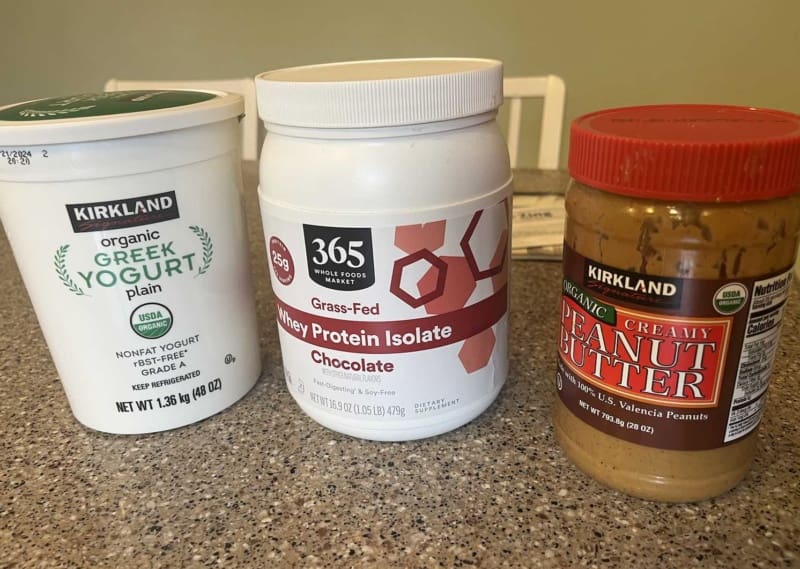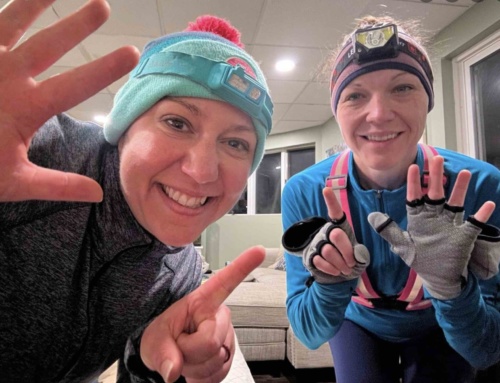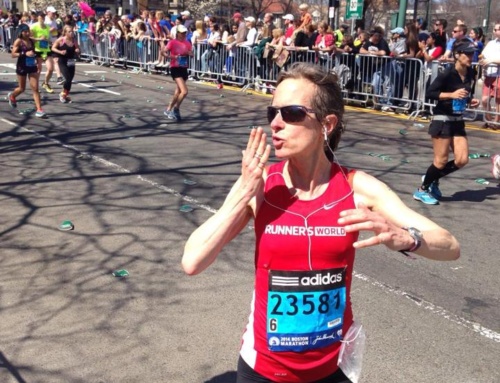
My evening snack: House brands for the win!
Unless you’ve been hiding under a box of family-size Honey Nut Cheerios, you know that protein consumption is all the rage these days. It’s as trendy as wondering where Kate Middleton is or complaining that the Barbie Movie was robbed at the Oscars. Unlike snooping around the royals or dissing on I’m Just Ken, protein, however, is a worthy trend, especially if you have an active, aging body like I do.
This past year, despite lifting heavy weights three times a week and keeping most of my endurance activities in a low aerobic zone, I have gained weight and lost muscle tone. I type that as a fact, not as a complaint. At age 51, I am doing my best not hate on my body or consciously swim upstream against declining hormones and all the other natural, albeit unnerving, treats menopause brings. (I’m not a salmon, nor do I like to eat salmon…more on that in a bit.)
I do, however, want to be active and strong for decades to come, and I’d like to continue to look like the athlete I am. Or, as Dr. Stacy Sims said on a recent AMR podcast, “You want to be the oldest person in the gym, not the youngest person in the nursing home.” A building block for muscle maintenance and growth, protein helps prop open the door to the gym—and keeps the door to the nursing home shut.

In Next Level, her advice-laden guide for menopausal women, Sims recommends 2-2.2 grams/protein per kilogram of body weight for those of us who do moderate training most days of the week. Heavy training is at least 2.5 hours a day, which is not me these days. If you’re not menopausal, she’ recommends between .8/1.2 grams of protein per pound of body weight, which is pretty similar to the Next Level recommendations.
Doing the math for my 6’4″, 190-pound body, and I’m looking at 172-190 grams of protein daily. That is not an insignificant amount, which is why I probably why I’ve never tracked my consumption. It felt too overwhelming.
[Quick break: I don’t want this to be triggering to anybody, so if you’re like, hmmm…maybe I should stop reading, please do.]
Recently in both Many Happy Miles and Many Nutritious Miles, we have focused on prioritizing protein with Jenn Giles, MS, RDN, CSSD, so I decided to jump into the bone broth and see if I’m actually eating close to what would be most helpful for my body.
I tracked protein for about five days, using in the notes feature of my phone instead of getting too deep into a nutritional tracker. The good news: I was getting plenty of protein the morning and at lunch, then typically hit a lull when I snacked and sometimes at dinner.
THE NUMBERS: PROTEIN GRAMS IN ONE DAY
I won’t bore you with every gram I consumed, but here’s what a typical day looked like once I ironed out a few things. To be clear: this is not the full menu of what I ate; it’s simply the ingredients that provided a significant amount of protein. (Read: I still ate greens, other veggies, fruits, and a cookie or two.)
PRE-WORKOUT SNACK
Banana + 1 tbsp Almond Butter: 3 g
BREAKFAST
Post-workout chocolate milk: 13 g
Eggs (2 full + 1 egg white): 18 g
2 handfuls of spinach: 3 g
1 piece Dave’s Killer Bread: 5 g
Oat milk latte with 2 scoops collagen: 9 g
MORNING TOTAL: 51 grams
LUNCH
Stocked salad, including
2 handfuls of spinach: 3 g
2 chicken sausages: 24 g
1/4 cup chickpeas: 5 g
1/4 cup pumpkin seeds: 10 g
2 PM SNACK
Rx Bar: 12 g
AFTERNOON TOTAL: 54 grams
DINNER
Chicken curry: 30 g
1.5 cup brown rice: 7 g
PRE-BED SNACK
2/3 cup of Greek yogurt: 18 g
1/2 scoop whey protein isolate: 13 g
1 tbsp peanut butter: 4 g
EVENING TOTAL: 72 grams
DAY TOTAL: 177 g
Bingo! Coming in hot between the 172-190 gram recommendation.
I am a very routine eater, so I eat a variation of that breakfast most mornings and a variation of that lunch most days as well. (My other favorite lunch is Curried Lentil Soup from Run Fast Eat Slow; I add 2 tbsp of nutritional yeast to each bowl to up the protein by 8 grams.)
Dinner I can get a little crazy—Taco Wednesday, anybody?—but try to make sure there’s a solid protein source, whether it’s meat, Barilla Protein+ Pasta, or beans.
THE TAKEAWAY: SIX PROTEIN TIPS
While five days isn’t a super long stretch—and this experiment is an n=1—I can offer these six takeaways that may be helpful as you think about protein:
#1: I feel physically solid when I prioritize protein. Which is probably because I feel full most of the time. It may sound woo-woo, but I truly feel like I’m feeding my muscles, helping them maintain their strength and size while keeping my frame sturdy. It’s not like my three-egg breakfast ensures I won’t ever break a bone again, but I feel like I’m supporting, not fighting against, my body, which hasn’t always been the case for me.
#2: Related: I also feel more emotionally solid. That hangry feeling no longer lurks around every corner, waiting to catch me in its net of irritability and emptiness. Again, a little woo-woo, but go with me here: with a focus on protein, I feel more mentally grounded. I’m still emotional—this is me during menopause, after all—but I haven’t felt that vacant sadness that can often make me spiral lately.
#3: Just like exercise, sleep, and all the other things you do to benefit your body, protein requires some prep work, even if you’re not a meat eater. (It never fails: I always forget to press out a block of tofu.)
It’s best to have few dinners planned out, so you can defrost meat with ample time for marinating time, or set up a slow cooker in the morning for an evening meal. (Nothing feels worse to me than getting lost in morning work, forgetting about a planned dinner, then doing the math and thinking, “Ok, we won’t be eating until 9 pm.”) Lately, I have been baking a few chicken breasts every Sunday to have for lunch and fill-ins for quick dinners.
#4: Similarly, protein-forward snacks require a little thought. How quickly will you go through that tub of yogurt or cottage cheese or those DIY roasted chick peas? Faster than you think, in my experience. I am still on the prowl for a protein-rich bar made with minimal ingredients that I actually tastes good to me. I realize they are a danger to my teeth, but RX bars continue to be my go-to for bars.
#5: I definitely need to expand my vegetarian options. Mainly for environmental/ethical reasons (hello, You Are What You Eat), partly for financial reasons (meat, bars and protein powder are not cheap!), but also because I am just sick of meat. (I don’t care for fish or seafood, so those are both out.) This simple tofu recipe is on rotation, and I also use tempeh regularly. Other veggie options I keep stocked: plenty of beans; chickpeas (easy to toss into curry or on a salad); nutritional yeast; seeds and nuts.
#6: The best addition to this protein experiment? A yogurt snack before bed. While my sleep these days often resembles a taxi in NYC—stop, go, stop, go—a protein-rich snack before bed seems to cut down a bit on the restlessness. I’ll take it.






Love this and the modified food diary. Turns out our eating habits are super similar- except for some fun add ins like chickpeas and pumpkin seeds! Definitely going to test out some of your variations! Thanks!
Awesome, Dimity! Some days I feel like it’s impossible to hit my 125 g protein goal, but your post gives me lots of ideas for where to add. Thank you!
I am 20 years older than you and you CAN maintain and even build some muscle as you age! I don’t count anything when it comes to food, but I FUEL and RE-fuel when I eat- yes to the bone broth and chicken, fish (tuna, salmon and SASHIMI!) and nuts/seeds for snax.
This is so helpful, Dimity! Your honest self-assessment is so relatable and inspires me to work harder toward my daily protein target! And the six protein tips are packed with implementable ideas!
Ever since cancer (22 months ago), I absolutely prioritize protein. Loving all the great ideas; going to try protein powder in greek yogurt with PB for sure! Because of the weight loss caused by treatment side effects and eating difficulties, I’ve learned that if I don’t prioritize protein, everything suffers. Currently am able to tell without tracking (though I do track every day as it’s work to stay nourished when you can’t really chew) when I am short of protein. Thanks for the honestly and sharing what’s working for you – it really helps!
I ahould eat about 114-120 grams of protein a day and maybe more because most days of the week I do more than 2 hours of activity. I am going to track what I eat and see if it adds up. I think I am chronically underfed.